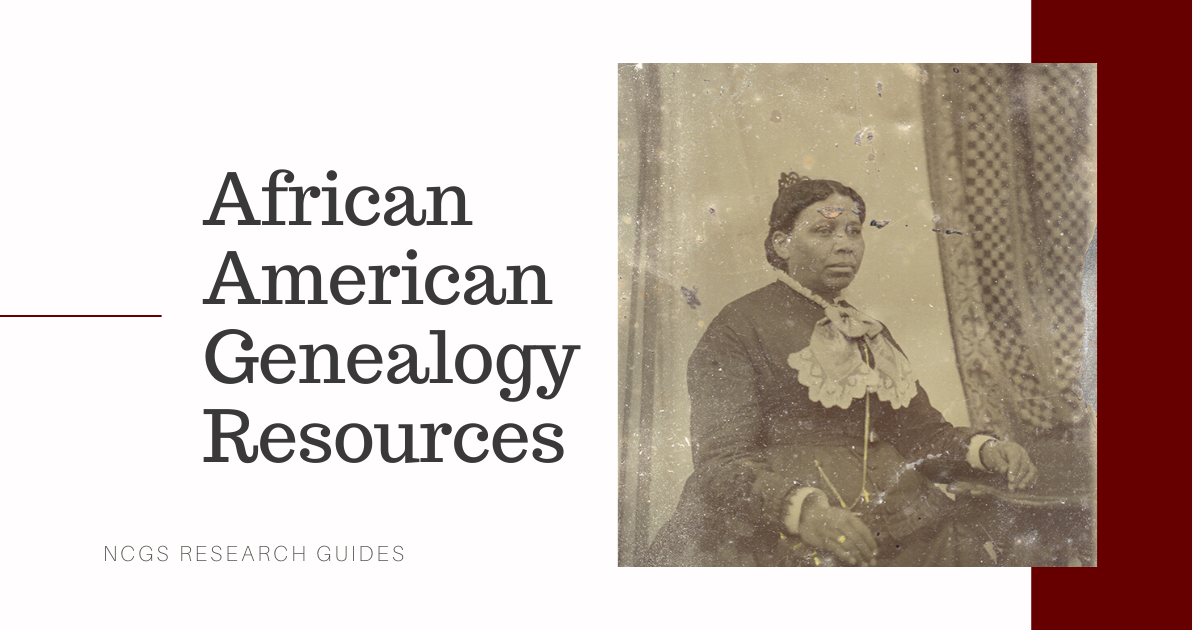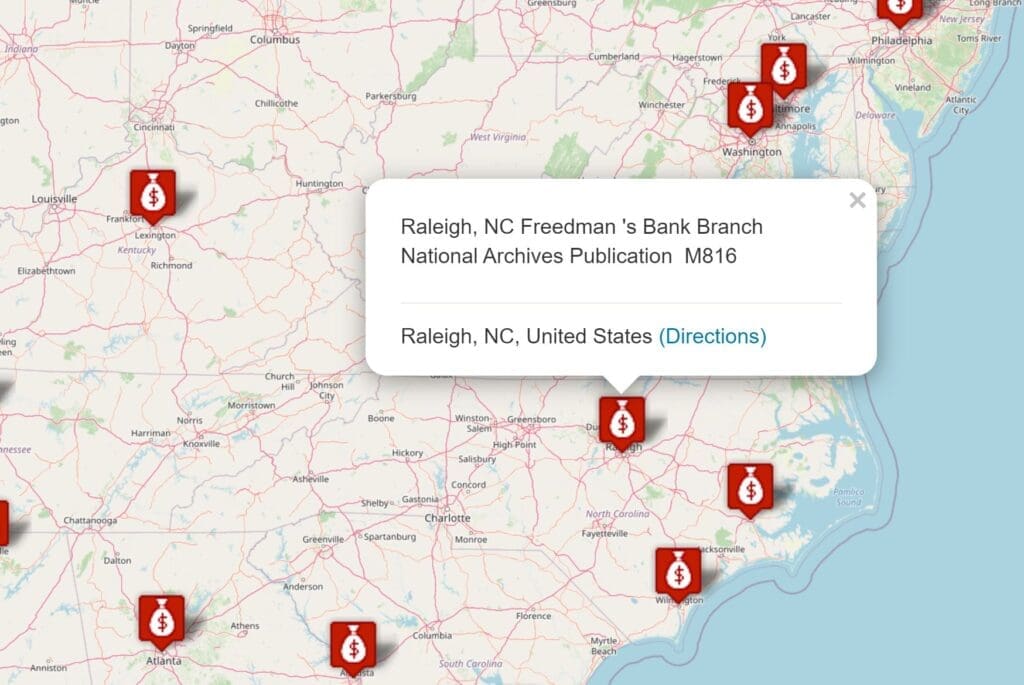A guide for connecting you with resources for finding your African American ancestors
The African American Genealogy Resources Guide will connect you with various online resources that may assist in your African American research endeavors.
- NCGS Webinars
- Slave Voyages
- Afrigeneas Slave Data Collection
- North American Slave Narratives
- Digital Library on American Slavery by UNC Greensboro
- Federal Slave Census Schedules
- Born in Slavery: Slave Narratives from the Federal Writers’ Project, 1936 to 1938
- Slavery Era Insurance Registry
- Civil War & Pension Files
- African American Freedmen’s Bureau and Freedman’s Bank records
- Mapping the Freedmen’s Bureau
- Free African Americans
- Last Seen
- Forgotten Patriots
- Documenting the American South
- Virginia Untold
Online Collections and Databases
NCGS Webinars
Black and White Southern Families in Antebellum Plantation Records by Ari Wilkins
The Southern Antebellum Plantation Records are an invaluable resource to Southern and African American researchers. This extensive collection encompasses business and personal papers from numerous slaveholding families of the South. For white Southern families, the collection can uncover decades of genealogical history along with details such as the dynamics of personal relationships, communication, and the entanglements of associated families. For African American research, these records can potentially list enslaved persons by name and include other significant information such as family relationships, dates of birth and death, and bills of sale. This presentation will demonstrate the breadth of the collection, and how to navigate and apply the records to personal research.
Freedmen’s Bureau Records by Diane L. Richard, ME, MBA
Are you seeking records for your southern ancestors in the immediate post Civil War time period (1865-1868)? Learn about this little known and used Federal record collection that is full of invaluable records for many ancestors, regardless of skin color or circumstances, who lived in North Carolina (or elsewhere from DE to TX). After the war many needed assistance, from maimed soldiers, to widows with children, to the aged and feeble, to ex-slaves and their former owners. Examples of records relating to rations, contracts and indentures, courts, abandoned land, schools, hospitals, and more are presented.
Finding Black Roots in a White World by J. Mark Lowe, CG, FUGA
Learn how to find African American family members in the pre-1870 United States. Utilize the tools and techniques that will help you identify and find resources to lead you to a family.
Mysterious Relatives by Ari Wilkins
Every genealogist has that mysterious relative – the ubiquitous ‘cousin’ who was always around with no obvious family connection. As researchers, we cannot figure out who this person is and how they are related to our family. Finding mysterious relatives on a census record, an entry in a family Bible, or old letters can yield invaluable insight into a family’s genealogy. Learn how to analyze and connect these mysterious relatives to your family history using census and vital records, newspapers, maps, etc.; contextual clues; “FAN club” methodology; and more.
Slave Voyages
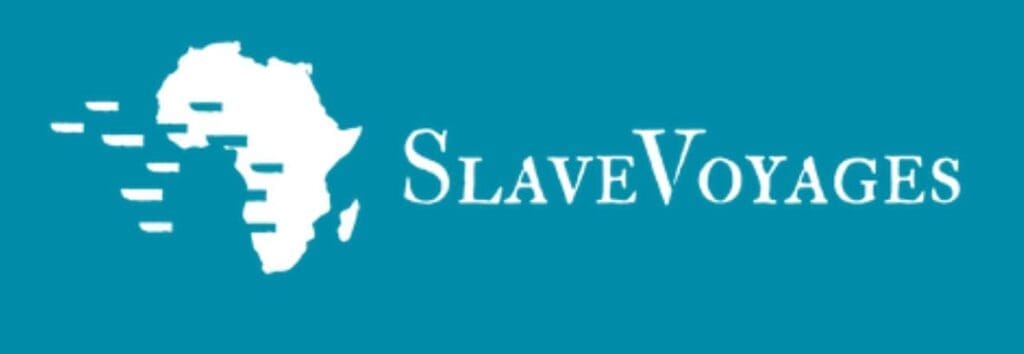
Slave Voyages is a “digital memorial that raises questions about the largest slave trades in history and offers access to the documentation available to answer them. European colonizers turned to Africa for enslaved laborers to build the cities and extract the resources of the Americas. They forced millions of Africans across the Atlantic to the Americas, and from one part of the Americas to another. Analyze these slave trades and view interactive maps, timelines, and animations to see the dispersal in action.”
The website includes a trans-Atlantic database & intra-American database. “This website does provide the African names of and personal information of about 91,491 captives who were found on board slave vessels detained by naval cruisers attempting to suppress the slave trade in the nineteenth century. These records can be searched and analyzed using the names interface. Although of limited utility for persons seeking their own family histories, our data set does provide an extraordinary source for historical reconstruction of the history of the African peoples in America.”
Afrigeneas Slave Data Collection

Records kept by slave owners are often the only clue to the identities of enslaved people, particularly during the period 1619-1869. The Afrigeneas Slave Data Collection was designed to assist African-ancestored researchers throughout the Diaspora to find a path to the last slaveholder or the suspected last slaveholder.
The site is also designed to assist descendants of slaveholders and other researchers, to share information they find with any slave reference in records including, but not limited to:
Advertisements
Apprenticeship
Bible Records
Bills of Sale
Birth Records
Census Schedules
Church Records
Cohabitation
Court Records
Day Books/Logs
Death Records
Diaries-Journals
Inventories
Legislative Acts
Letters
Litigation
Manumissions
Marriage Records
Military Records
Miscellaneous Records
Plantation Records
Pension Records
Run-A-Ways
Slave Owners
Slave Sales
Tax Records
Wills
North American Slave Narratives
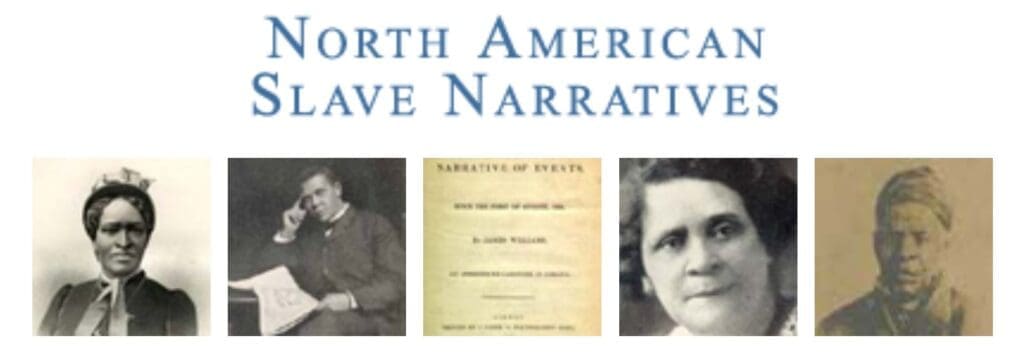
“North American Slave Narratives collects books and articles that document the individual and collective story of African Americans struggling for freedom and human rights in the eighteenth, nineteenth, and early twentieth centuries. This collection includes all the existing autobiographical narratives of fugitive and former slaves published as broadsides, pamphlets, or books in English up to 1920. Also included are many of the biographies of fugitive and former slaves and some significant fictionalized slave narratives published in English before 1920.”
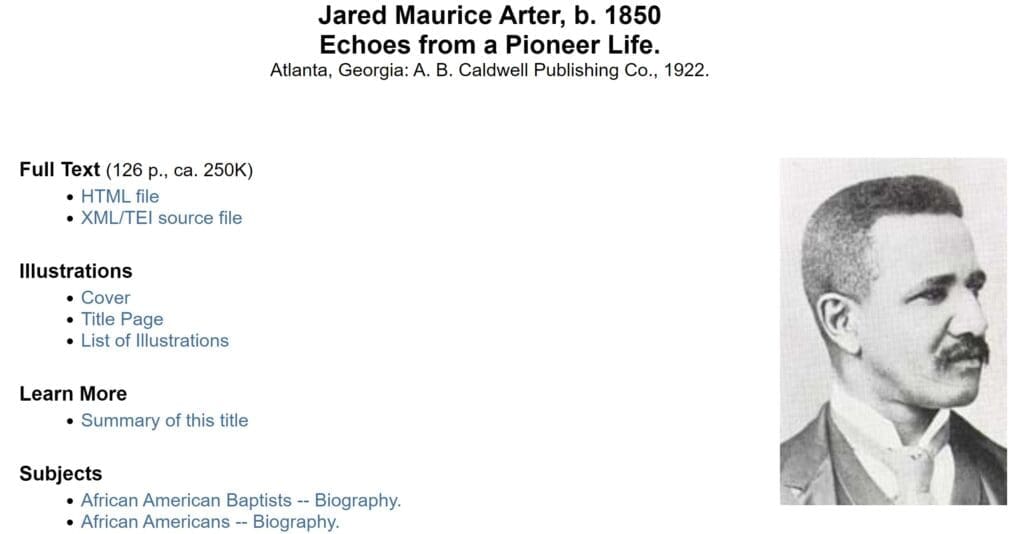
Digital Library on American Slavery by UNC Greensboro
The Digital Library on American Slavery maintains multiple online collections featuring records tied to slavery in the United States. These collections include:
Race and Slavery Petitions Project which “contains detailed information on about 150,000 individuals, including slaves, free people of color, and whites, extracted from 2,975 legislative petitions and 14,512 county court petitions, as well as from a wide range of related documents, including wills, inventories, deeds, bills of sale, depositions, court proceedings, amended petitions, among others. Buried in these documents are the names and other data on roughly 80,000 slaves, 8,000 free people of color, and 62,000 whites, both slave owners and non-slave owners.”
NC Runaway Slave Advertisements “provides online access to all known runaway slave advertisements (more than 2,300 items) published in North Carolina newspapers from 1751 to 1840. These brief ads provide a glimpse into the social, economic, and cultural world of the American slave system and the specific experience within North Carolina. The NCRSA website includes digital scans of the ads, contextual essays to address their historical research value, full text transcripts, an annotated bibliography to aid researchers, and a searchable database.”
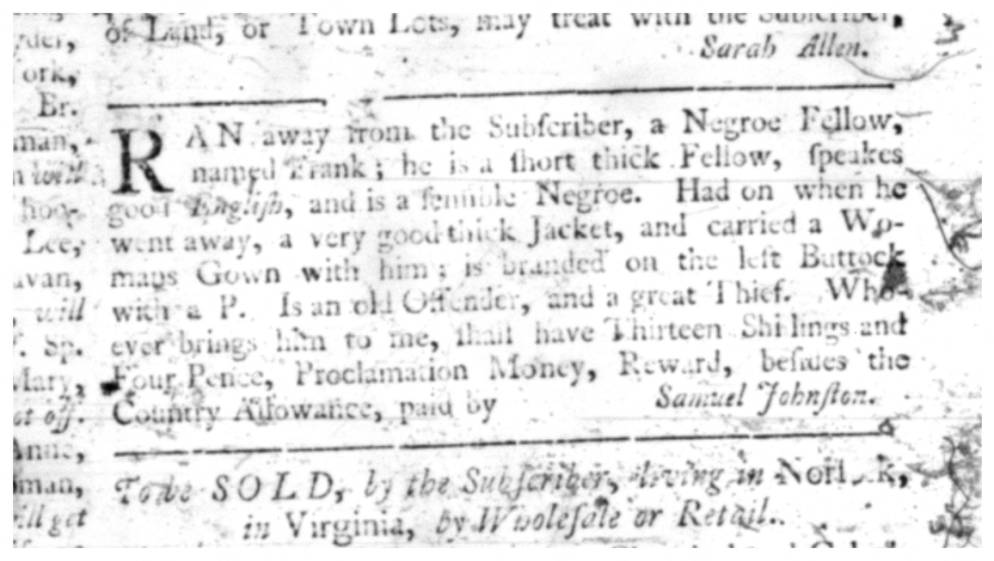
People not Property – Slave Deeds of North Carolina. This “project is leading towards a unique, centralized database of bills of sales indexing the names of enslaved people from across North Carolina. Until completed, they are aggregating and linking to the individual efforts of several counties.”
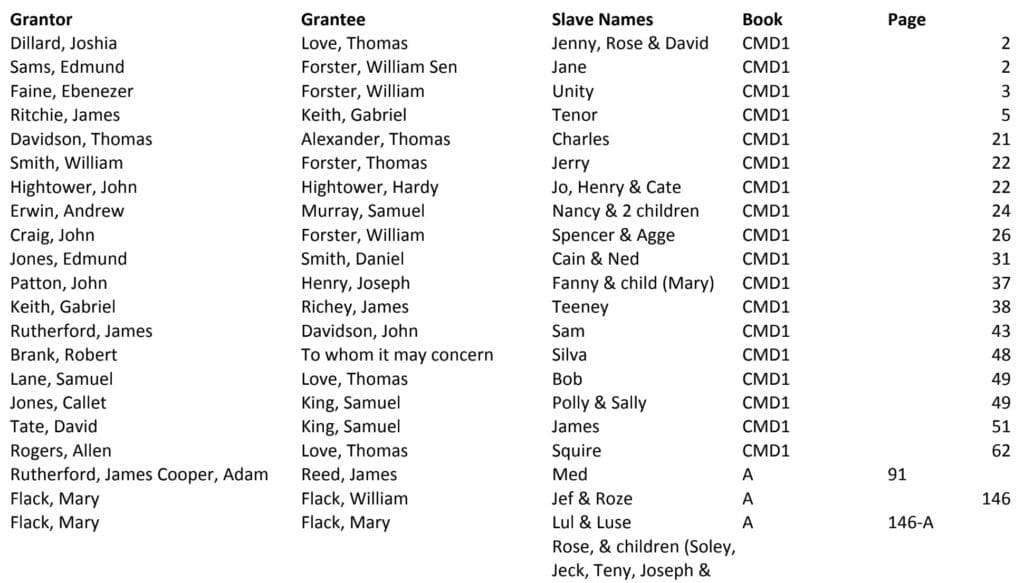
Federal Slave Census Schedules
In 1850 and 1860, the United States enumerated census schedules of enslaved individuals. These censuses accounted for unnamed enslaved individuals under the name of their enslaver. The schedules exist for Alabama, Arkansas, Delaware, District of Columbia, Florida, Georgia, Kentucky, Louisiana, Maryland, Mississippi, Missouri, New Jersey (1850 only), North Carolina, South Carolina, Tennessee, Texas, Utah Territory, and Virginia. Digital copies can be accessed online in the following locations:
- 1850 Federal Slave Census Schedule: Family Search (free), Ancestry ($)
- 1860 Federal Slave Census Schedule: FamilySearch (free), Ancestry ($)
In 1860, for each slave owner the following information is provided:
- Number of slaves owned
- Number manumitted (freed) in the year preceding June 1
- Age, gender, and color of slave
- If a slave is a fugitive, from what state
- If deaf and dumb, blind, insane, or idiotic
- Number of slave houses on that owner’s property
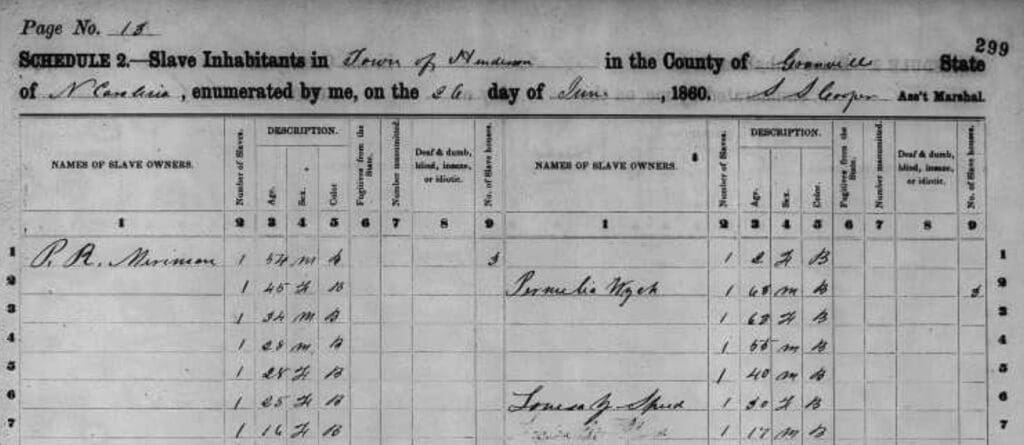
Born in Slavery: Slave Narratives from the Federal Writers’ Project, 1936 to 1938

“Born in Slavery: Slave Narratives from the Federal Writers’ Project, 1936-1938 contains more than 2,300 first-person accounts of slavery and 500 black-and-white photographs of former slaves. These narratives were collected in the 1930s as part of the Federal Writers’ Project (FWP) of the Works Progress Administration, later renamed Work Projects Administration (WPA). At the conclusion of the Slave Narrative project, a set of edited transcripts was assembled and microfilmed in 1941 as the seventeen-volume Slave Narratives: A Folk History of Slavery in the United States from Interviews with Former Slaves. In 2000-2001, with major support from the Citigroup Foundation, the Library digitized the narratives from the microfilm edition and scanned from the originals 500 photographs, including more than 200 that had never been microfilmed or made publicly available. This online collection is a joint presentation of the Manuscript and Prints and Photographs divisions of the Library of Congress.”

Slavery Era Insurance Registry
In August 2000, the California legislature found that, “Insurance policies from the slavery era have been discovered in the archives of several insurance companies, documenting insurance coverage for slaveholders for damage to or death of their slaves, issued by a predecessor insurance firm. These documents provide the first evidence of ill-gotten profits from slavery, which profits in part capitalized insurers whose successors remain in existence today.” SB2199 Sec. 1(a). This registry includes insurance claims from multiple states.
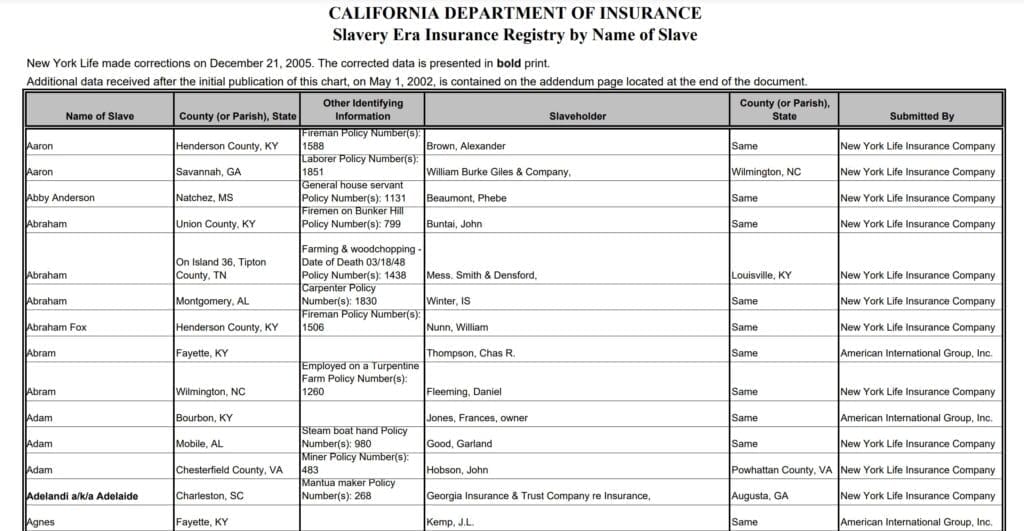
Civil War & Pension Files
During the Civil War, thousands of African-American men served in the Union Army in the U.S. Colored Troops as well as in the U.S. Navy. Records of their military service can be found in Compiled Military Service Records.
After the war, these men, and wives and children who outlived them, may have been eligible for a government pension. The pension application file can contain a wealth of information.
In the southern states, the Confederate Government required many slave owners to provide enslaved persons to work on the war effort throughout the South. “The payrolls for that slave labor that usually indicate the name and place of residence of the slave owner; name of slave; month(s), year(s), during which the slave was employed, the location at which the slave was employed, the Confederate officer under whom the work was performed, the number of days worked, the daily rate of pay and the total amount paid.”
Learn more about how to find Civil War & Pension records.
African American Freedmen’s Bureau and Freedman’s Bank records
The Bureau of Refugees, Freedmen, and Abandoned Lands, also known as the Freedmen’s Bureau, was established in 1865 to supervise and manage matters relating to refugees and freedmen. You can search the world’s largest digitized and searchable collection of Freedmen’s Bureau and Freedman’s Bank records to date, with more than 3.5 million records available for everyone to search for free at www.Ancestry.com/Freedmens.
You can also search an index of census returns, registers, and lists of freedmen for free at FamilySearch.org or access Freedmen’s Bureau records at the National Museum of African American Culture & History. The Museum has collaborated with the Smithsonian Transcription Center to transcribe more than 1.5 million image files from the Freedmen’s Bureau records. Once completed, the Freedmen’s Bureau Transcription Project will allow full text searches that provide access to both images and transcriptions of the original records.
The Freedman’s Savings and Trust Company, commonly called the Freedman’s Bank, was created to assist newly emancipated individuals and African American soldiers at the end of the Civil War. While the bank failed in 1874, it’s records remain. One of the most beneficial sets of records are the registers of signatures of depositors.
The registers from 29 branches from 1864 to 1871 show the names, residence, and description of each depositor. They may also include the genealogy and relatives of the depositor. Most depositors were African Americans.
FamilySearch provides multiple Freedmen’s Bureau and Freedman’s Bank collections featuring thousands of indexed and unindexed images.
To see what Freedmen’s records are available for free at Family Search, follow the directions below.
- Visit FamilySearch.org.
- Click on “Search” on the top menu bar.
- Select “Records” from the dropdown menu.
- Scroll down and select “browse all published collections” from the bottom right.
- Under filter by collection title, type “Freedmen.” This will pull up all collections related to the Freedmen’s Bureau and Freedman’s Bank.
Mapping the Freedmen’s Bureau

“Mapping the Freedman’s Bureau is devoted to helping researchers put their ancestors back on the historical landscape where they lived. During those critical years after the Civil War, many once enslaved people found themselves in a dangerous situation. Many had freed themselves and taken refuge after making their way “to the Union Line.” But once they arrived at the line, their fate was uncertain. Within months many found themselves living in contraband camps. They had been declared “contrabands” by Gen. Benjamin Butler in 1861, when three men (Shepard Mallory, Frank Baker, and James Townsend) were the first to take refuge at the Union encampment at Ft. Monroe, Virginia.
The most critical function was to serve the newly freed people, as a new world opened for them. In those first critical years after freedom came, a new reality unfolded for the entire southern population, and people from every aspect of life needed assistance. So the Bureau of Refugees, Freedmen and Abandoned Lands was created.
But the Bureau however, served all who needed intervention. The “Freedmen” were Black, the “Refugees” were white and the “Abandoned Lands” once owned by the landowners were eventually re-settled, after oaths of allegiance from former secessionists were taken.
Mapping the Freedmen’s Bureau is devoted to pointing out the many places that affected the newly freed survivors of slavery. The sites where Freedman’s Bureau offices were located are marked for you. In addition other institutions that served former slaves, are marked – the branches of the Freedman’s Savings Bank, Freedmen Schools, contraband camps, and even the location of battle sites where men who were in the US Colored Troops fought.
The purpose of this mapping project is to allow genealogical researchers to not only discover if their ancestors lived near one of these important sites. In addition, local historians may also discover some forgotten history about their own local community. All of this information is presented to provide researchers, from the professional to the novice, a useful tool to more effectively tell the story. We hope that you will find this to be a valuable tool in your research, and that you will be able to determine more components of the family story, the local history and the greater story of the nation.”
Free African Americans
Free African Americans is run by Paul Heinegg who researched the family histories of most free African American families in North Carolina, South Carolina, Virginia, Maryland, and Delaware. Heinegg published two books, accessible for free on Free African Americans, containing about 2,700 pages of family histories based on all colonial court order and minute books on microfilm at the state archives of Virginia, Maryland, North Carolina and Delaware (over 1000 volumes), tax lists, wills, deeds, free Negro registers, marriage bonds, parish registers, Revolutionary War pension files, etc.
Also included are another 5,000 pages of abstracted colonial tax lists and Virginia personal property tax lists.
Last Seen

“Last Seen is recovering the stories of families separated in the domestic slave trade. You can search thousands of Information Wanted Ads taken out by former slaves to look for your ancestors, help us transcribe these ads, and find out how educators are using these family stories in their classrooms.”
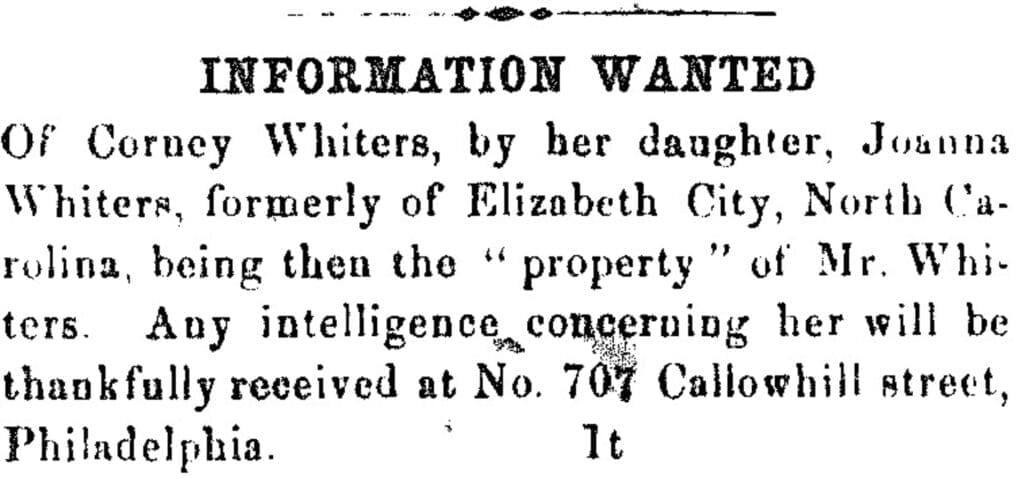
Forgotten Patriots
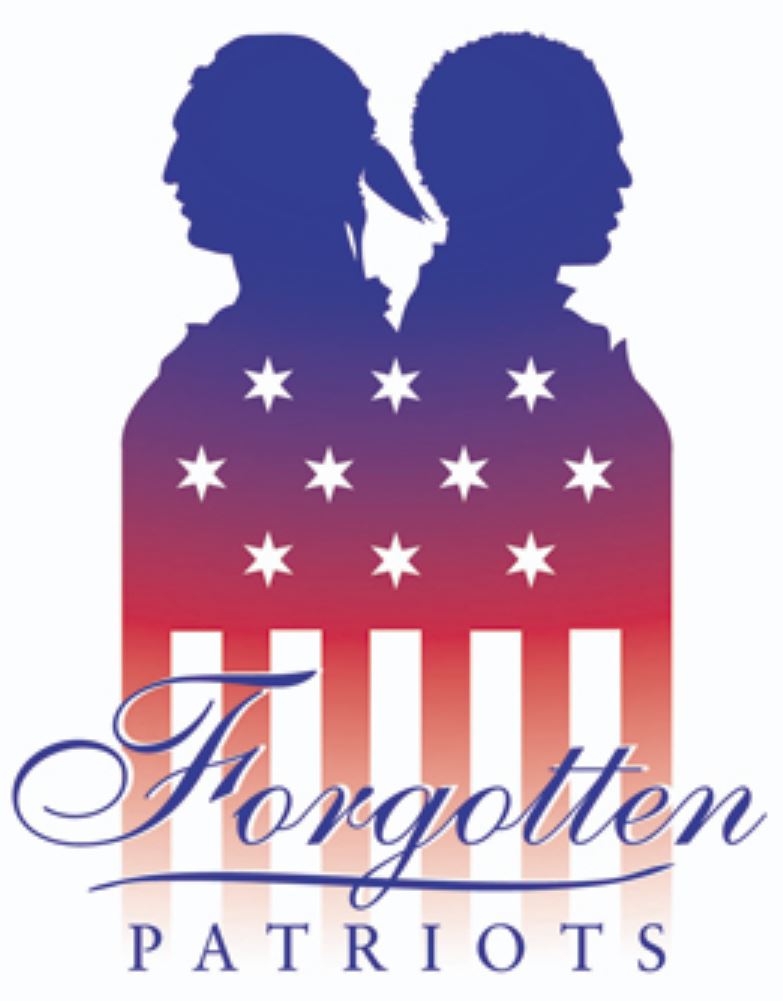
The Forgotten Patriots Project focuses on the important contributions made by African American and American Indian patriots of the American Revolution. To date, thousands of Forgotten Patriots have been identified, and DAR researchers continue to uncover these individuals and their unique stories.
Since the mid-1980s, the National Society Daughters of the American Revolution has supported a project to identify the names of African Americans, Native Americans, and individuals of mixed heritage who supported the American struggle for independence from Great Britain during the American Revolution. In the 1980s and 1990s, a series of small booklets for each of the original states were published, and in 2001 these booklets were merged into one volume and their contents greatly expanded in the publication titled African American and American Indian Patriots in the Revolutionary War.
The 2001 book also inspired a well-received and interesting exhibition in the DAR Museum “Forgotten Patriots: African American and American Indian Service in the Revolutionary War, 1775-1783.” The exhibition was open to the public from the fall of 2002 to the summer of 2003. During the exhibition’s run, a seminar on the same topic was held at DAR Headquarters in Washington, D. C. in January 2003 and featured noted historians from around the country.
During the next few years, DAR researchers continued to build on the 2001 book, and by 2006 it became clear that a new publication was needed to present all of the additional findings. In April 2008, DAR published Forgotten Patriots: African American and American Indian Patriots in the Revolutionary War, an 874-page expansion of the 200-page publication. In the three years since this book was published, research continued and new findings have been complied in a supplement that is now available.
Documenting the American South
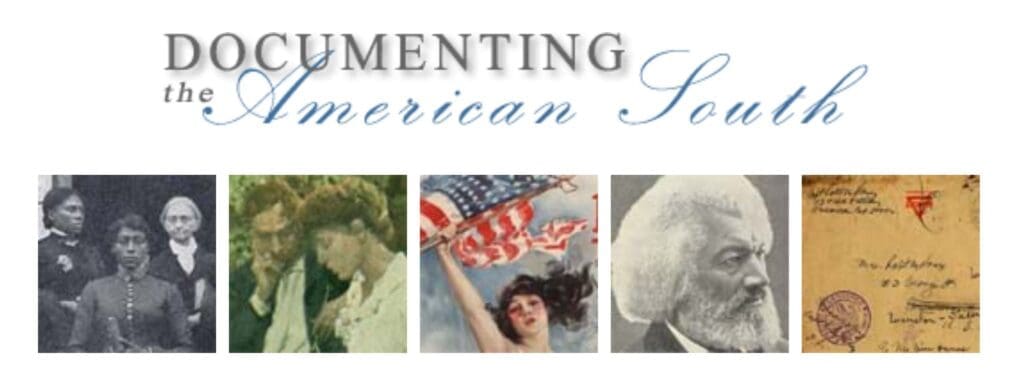
“Documenting the American South (DocSouth) is a digital publishing initiative that provides Internet access to texts, images, and audio files related to southern history, literature, and culture. Currently DocSouth includes sixteen thematic collections of books, diaries, posters, artifacts, letters, oral history interviews, and songs.
The University Library of the University of North Carolina at Chapel Hill sponsors Documenting the American South, and the texts and materials come primarily from its southern holdings. The UNC University Library is committed to the long-term availability of these collections and their online records. An editorial board guides development of this digital library.”
Virginia Untold

The Library of Virginia’s collections are rich with records documenting the lives of African Americans in Virginia. However, access to those materials dating from before the American Civil War is limited at best. These limitations are the result of period perspectives on the identities of enslaved and disenfranchised populations, as well as sheer volume. Due to this, the individual stories form a narrative of a people that has not been fully told.
The Library’s African American Narrative project aims to provide greater accessibility to pre-1865 African American history and genealogy found in the rich primary sources in its holdings. Traditional description, indexing, transcription, and digitization are major parts of this effort. However, and perhaps more importantly, this project seeks to encourage conversation and engagement around the records, providing opportunities for a more grassroots and diverse narrative of the history of Virginia’s African American people.
Articles & Blog Posts
FamilySearch Quick Guide to African American Records
How To Start Researching Your African American Female Ancestors by Lisa Lisson
Tracing Your African-American Genealogy by FamilySearch
Researching Formerly Enslaved African Americans by FamilySearch
Researching African American Ancestors by Ancestry
Genealogy Research Techniques for Finding Your Free People of Color by Lisa Louise Cook
Pre-1870 African American Genealogy Research: Oh, YES, We Can! by Renate Yarborough Sanders
Are there additional African American resources you’ve found beneficial in your research? Do you have a story about your African American ancestors you would like to share? If so, please email content@ncgenealogy.org.
*Updated June 19, 2021

